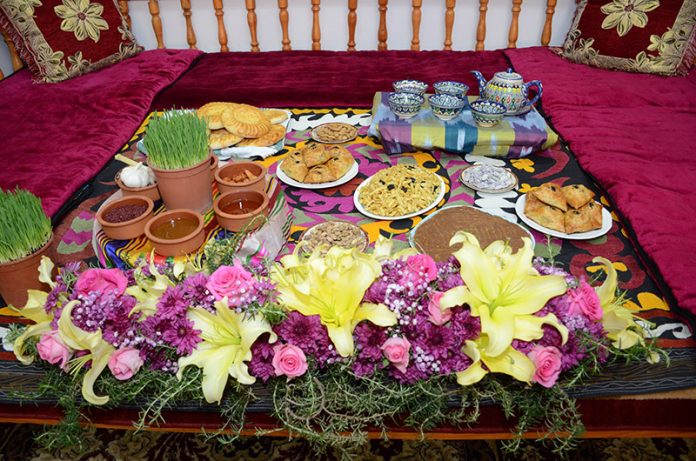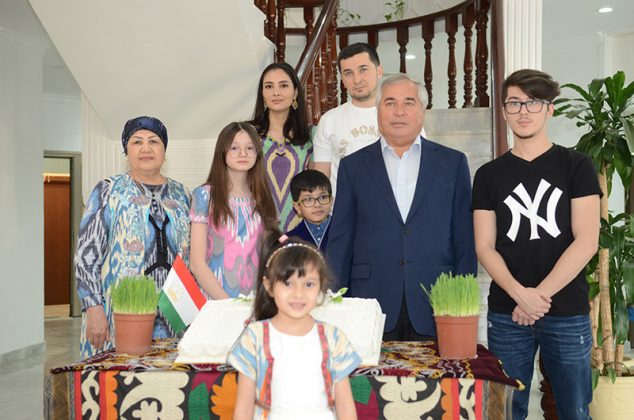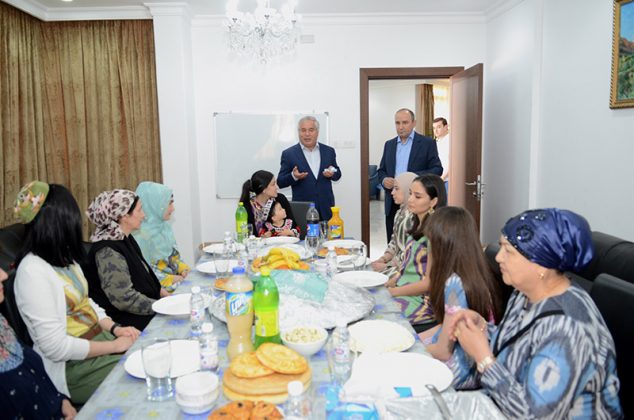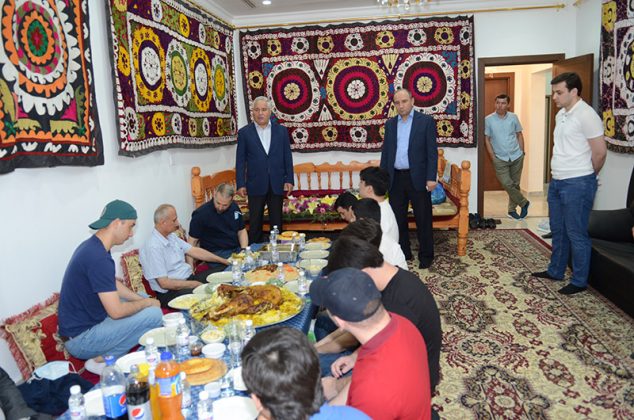Navruz Holiday is celebrated with great fervor throughout Tajikistan and is considered a great national holiday in the country. Passed on from generation to generation over centuries and millenniums, Navruz brings to contemporary Tajik people, the best ideals of life such as good thoughts, good words, and good deeds; respect for nature and humans; freedom and peace; appreciating the efforts of others and so forth.
Over the centuries, the celebration of Navruz encountered many political obstacles and social problems. Despite the challenges, Navruz always brought together people from various classes and social statuses around a common table of festivities that fostered peace, goodwill and forgiveness among people.
In the late 1980’s Navruz celebration was recognized by the Government of Tajikistan and 21 March was declared as a Navruz holiday. Following the independence of Tajikistan on 9 September, 1991 Navruz gained national status and is celebrated with all of its traditional rituals and customs throughout the country.
On 23 February, 2010 the United Nations General Assembly at its sixty-fourth session adopted the resolution declaring 21 March as the International Day of Nowruz, which was also included by UNESCO in its representative list as an intangible cultural heritage of 12 countries, including Tajikistan.
Recognizing Navruz as the national and traditional festival, Tajik people revived many rituals and customs related to Navruz, as well as organized several new festival competitions on the occasion, such as exhibition of the traditional dishes. Alongside to them were organized some new festival competitions like exhibition of the traditional dishes, national costume show and Miss Navruz competition.
Below we briefly describe some rituals and customs that have been organized in recent years.
Khonaburoron (Cleaning rooms): One or two weeks before Navruz, women and their daughters sweep and clean all rooms in the house and infuse them with perfumes, wash curtains and mattresses. They also clean kitchens and yards, wash the pots and pans, bowls, plates and kettles. The idea behind this cleaning is that before Navruz everything must be as clean as new, as a New Year is approaching and the house and its environment must be symbolically purified.
Gulgardoni (bringing new flowers): One of the first customs of Navruz, performed by children and adults is Gulgardoni to inform of the coming of spring. This custom is also called as Boychechak (“Snowdrop”) in Khujand, Sayri guli lola (“Tulip festival”) in Isfara, Idi guli surkh (“”Red flower festival”) in Istaravshan, Panjakent, Guli Siyohgush or Seyovush (the flower of Seyavosh or Flower with black ears) in the South districts of Tajikistan. The ceremony of informing the coming of spring consists of the following: Groups of children and adults go outdoors to the hills and valleys surrounding their homes to pick flowers such as snowdrops, irises, tulips. In many rural villages, the flower pickers then pass alongside the houses of their neighbors and other inhabitants while singing special celebratory and congratulatory songs.

Navruz Dishes: Traditional Navruz dishes also are prepared with different grains and herbs symbolizing the fruitful nature and healthy food. In the Hisar district during spring celebration in many houses, women cook gandumkucha, a dish that incorporates ground wheat, beans, peas, sorrel, onion, mint, salt and water. In some other regions of Tajikistan this dish is also called as dalda (Kulab, Yavan), baj (Badakhshan), gouja (Panjakent), with the recipe modified to include various other grains and herbs. Sumanak is the most widespread and traditional Navruz food. It is a sweet pudding made from germinated wheat, symbolizing affluence. Two weeks before the celebration, women in many villages begin sprouting grains of wheat in plates to a height of a few inches, and on the celebration day they bring their germinated wheat to the ‘idgoh’ or celebration yard, where they cook sumanak in a big pot.
Preparing sumanak is hard work and it is difficult for one person to cook it on their own, as the contents in the pot have to be regularly mixed for the 15 to 20 hours it takes to cook the dish. The whole process of preparing sumanak continues one day and night and therefore young men and women also join them in some villages. Women playing the doira (daf, dafcha) which is a musical instrument similar to tambourine, sing folk-songs about Navruz, spring and satiric quatrains, and dance to the music. There is a belief that if you welcome the new year joyfully with music, songs and dance, then the whole year ahead will be happy and prosperous for you. The women usually start their entertainment part of this ritual singing collectively the well-known folk-song “Sumanak dar jush mo kafcha zanem”.
Oshtikunoni (reconciliation): is another custom, which is carried out before the Navruz. Before the eve of Navruz, people should forgive the offence of each other, or in other words, nobody should be offended with another in the welcome days of next year.
Navruz Entertainment: On the entertainment side, Navruz celebrations are marked by traditional sports and games, and contests such as wrestling, running, buzkashi (goat-snatching). In addition to these competitions, in many places non-traditional or contemporary sporting events such as football, basketball, volleyball and tennis take place. In villages many children and adults also hold wrestling, cockfighting, egg-fighting, and other entertainments.
But the most widespread sporting event during the Navruz contests is without doubt ‘Gushtin’, which is the national wrestling style. In every village, towns, district centers and cities alike ‘Gushtin’ wrestling events are a common sight during Navruz as competitors vie for special Navruz prizes.
In addition to the above mentioned customs during Navruz celebration, in many places various other competitions are organized, including contests to determine best traditional costumes, national dishes, dancing and singing events and Miss Navruz competitions. The bride-and-groom show in traditional dresses is also a usual custom in which young spouses are seen as the symbol of a new year and their traditional costume refers to the old traditions of Navruz.
There are many rubais, quatrains, and folk-songs dedicated to Navruz in the Tajik Folklore, which are usually performed in the beginning of spring and during the Navruz festival days. The main meaning reflected in many Navruz quatrains lies in the opposing forces of winter and spring; acknowledging humans as part of nature; and identifying Navruz with freedom., opposing the winter and spring; considering the human as a part of nature, and identifying Navruz with freedom.
The theme of Navruz festival is also one of the favorite themes of Tajik poets. Starting from Rudaki, the establisher of the Persian-Tajik Literature, to modern poets, there is no Tajik poet who did not compose some lines about Navruz.
Navruz is a means and a cause for gathering, communicating, enjoyment, getting aesthetic delight, remembering one’s ancestors and expressing the close connection between humans and nature. Moreover, by participating in the social gatherings people feel as a member of the larger society. Navruz is the festival without borders that belongs to people of different ethnical backgrounds, languages, religions, gender, ages and social statuses.
Popular festival in many countries

Navruz is a popular festival in many countries in Central Asia, including Tajikistan. The word Navruz consists of two roots — ‘nav’ which means ‘new’, and ‘ruz’ which denotes ‘day’. The word originated from the basic Pahlavi language, in which it is pronounced as ‘Nug Ruj’. Various nations pronounce the word Navruz differently: Novruz, Naviyz (Arabs), Navruz (Persians and Tajiks), Nauryz (Kazakhs and Kyrgyzs).
Navruz falls on the day of the vernal equinox in the Solar Calendar, which was composed seven millenniums ago, long before the advent Islam in the region. According to the Solar Calendar, the year starts on 20 or 21 March on the day of the vernal equinox, when nature is believed to revive and the spring season starts.
Navruz foods: In Central Asia none of the holidays can go without plov, which is a traditional dish cooked on Navruz. In addition, gudja (in some nations this is called halim, halisa) and sumalak (sumalyak, samanu) are indispensable dishes on the table at Navruz.
The process of preparing these dishes is time and labor intensive and takes a whole night, starting from the previous evening. Sumalak is prepared only by women, and gudja by men. Gudja is prepared by grinding together seven types of cereals that are then mixed with meat until it becomes one, before peas and other vegetables are added to the mix.
Sumalak is prepared from sprouted wheat, which is milled, and then boiled in cotton oil (some people cook in water). This dish is said to provide people with physical strength as it is very wholesome; it is also healthy as it is rich in vitamins and amino acids.
For preparation of sumalak, women in the family, or neighbors in big cities, gather around a large pot where they take turns in mixing the wheat that is being slowly cooked, to prevent it from burning. Women accompany the cooking through the night by narrating stories, singing songs or even dancing. In the morning, the sumalak is shared with everybody who participated in its cooking, as well as their neighbors, relatives and friends, carrying it from house to house in drinking bowls called ‘pialah’.
In some parts of Tajikistan, on the eve of Navruz, neighbors share treats and gifts with each other. It is also a widespread tradition among Tajiks to present gifts to children on Navruz, and to visit each other’s house as guests.




















